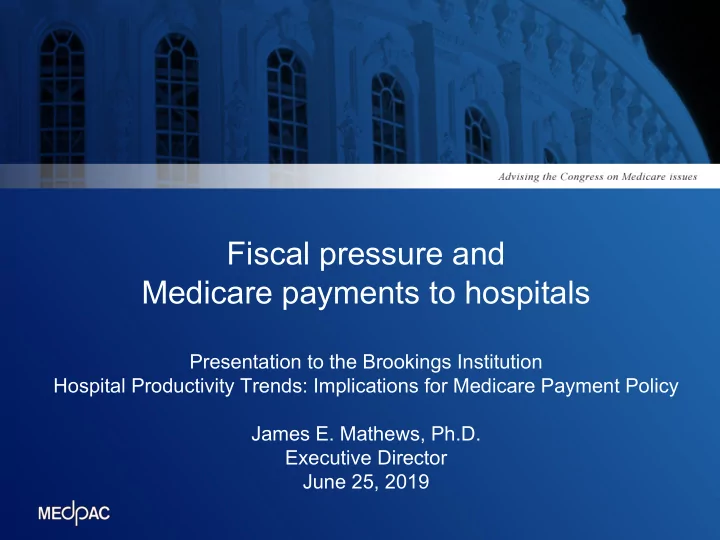

Fiscal pressure and Medicare payments to hospitals Presentation to the Brookings Institution Hospital Productivity Trends: Implications for Medicare Payment Policy James E. Mathews, Ph.D. Executive Director June 25, 2019
Outline of brief comments § Efficient hospitals – cost and quality § Readmissions § Overall cost growth trends – Medicare vs. commercial payers 2
Indicators of Medicare hospital payment adequacy are mostly positive § Access to care: Good § Inpatient and outpatient hospital use increased § Excess capacity with overall 62.5% occupancy § Marginal profit: +8% in 2017 § Access to capital: Strong access to capital markets § All-payer margin: +7% § Quality: Improving (lower mortality, improved patient experience) § 2017 Medicare margins: Declining § Aggregate margin: –9.9% § Efficient provider : –2% § 2019 projected aggregate Medicare margin: –11% Results are preliminary and subject to change. 3
Defining relatively efficient providers § MedPAC required by statute to assess “factors affecting expenditures for the efficient provision” of Medicare services § Principles for identifying relatively efficient providers: 1. Providers must do well on cost and quality metrics 2. Performance must be consistent over the past three years § Broad definition of “efficiency” in order to capture sufficient number of hospitals § Metrics used to identify relatively efficient hospitals: 1. Hospital-level mortality rates 2. Readmission rates 3. Standardized inpatient Medicare cost per case 4
Comparing performance of relatively efficient hospitals to others, 2017 Relatively efficient Other hospitals Measure hospitals Number of hospitals 291 (14%) 1,860 (86%) 30-day mortality (rel. to median) 7% lower 2% above 30-day readmissions (rel. to median) 5% lower 3% above Standardized costs (rel. to median) 9% lower 1% above Overall Medicare margin -2% -9% Note: Hospitals are classified as efficient based on 2014 to 2016 performance. In this slide, 2017 medians for each group are compared to the national median. Source: Medicare cost reports and claims data Data are preliminary and subject to change 5
Financial performance of relatively efficient hospitals under Medicare’s inpatient prospective payment system 6 Median Medicare margin (in percent) 4 4 2 2 2 1 2 0 -1 0 -2 -2 -5 -5 -5 -4 -6 -6 -6 -6 -9 -8 -9.9 -10 -12 2010 2011 2012 2013 2014 2015 2016 2017 Relatively efficient Other hospitals Note: Margins = (payments – costs ) / payments. Excludes critical access hospitals and Maryland hospitals. The overall Medicare margin covers inpatient, outpatient, hospital-based post-acute care in IPPS hospitals, graduate medical education, and other payments such as payments for the adoption of electronic medical records. Efficient hospitals exclude hospitals with Medicaid shares in the lowest 10% percent and hospitals in the 10% of markets with the highest service use due to concerns that socioeconomic status and aggressive treatment patterns can influence unit costs. Source: MedPAC analysis of Medicare cost reports from CMS. Data are preliminary and subject to change 6
Hospital Readmissions Reduction Program has been largely successful § The Hospital Readmissions Reduction Program (HRRP) created an incentive to reduce readmissions § Readmissions declined (at least partially due to the HRRP) § Observation and emergency visits increased, but may be largely due to reasons other than the HRRP § HRRP did not appear to negatively affect mortality rates 7
Effect of lower readmission rates on Medicare payments from 2010 to 2016 Type of care Change in payments (post-discharge) (in billions) Readmissions $ -2.28 Observation stays 0.17 ED visits 0.07 Annual change in spending -2.04 Note: Change in the annual payments for readmissions, observation stays, and ED visits post-discharge includes the cost of all changes, even if they did not stem from the HRRP. The $2 billion in reduced trust fund expenditures does not include reductions due to the penalties. Results are preliminary and subject to change 8
Over the last decade, cost of commercial insurance has grown twice as fast as Medicare costs 60 Employer-sponsored HMO premium growth for a single person 50 Employer-sponsored PPO premium growth for a single person Percent Change 40 Medicare per capita cost growth (excluding Medicare Advantage) 30 20 10 0 2007 2008 2009 2010 2011 2012 2013 2014 2015 2016 Data are preliminary and subject to change. Note: HMO (health maintenance organization), PPO (preferred provider organization), FFS (fee-for-service). Source: Employer-sponsored premium data from Kaiser Family Foundation surveys, 2007 through 2016. Medicare spending figures from Part A and Part B spending data from CMS actuaries; Part D spending per capita figures through 2015 from MedPAC analysis of claims and reinsurance data for individuals with Part D coverage. Part D spending for 2016 is a projection based on MedPAC analysis. 9
Discussion / questions § More info at www.medpac.gov 10
Recommend
More recommend